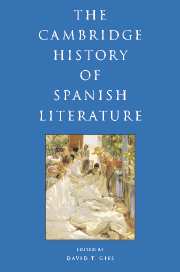Book contents
- Frontmatter
- I INTRODUCTION
- II HISTORY AND CANONICITY
- III THE MEDIEVAL PERIOD
- IV EARLY MODERN SPAIN: RENAISSANCE AND BAROQUE
- V THE ENLIGHTENMENT AND NEOCLASSICISM
- VI THE FORGING OF A NATION: THE NINETEENTH CENTURY
- VII THE MODERN, MODERNISMO, AND THE TURN OF THE CENTURY
- 32 Nineteenth-century women writers
- 33 The Catalan Renaixença
- 34 Great masters of Spanish Modernism
- 35 The poetry of Modernismo in Spain
- 36 Modernism in Catalonia
- 37 Modernist narrative in the 1920s
- 38 Noucentisme
- 39 Ideas, aesthetics, historical studies
- 40 The Catalan Avant-Garde
- VIII TWENTIETH-CENTURY SPAIN AND THE CIVIL WAR
- IX IN AND OUT OF FRANCO SPAIN
- X POST-FRANCO SPANISH LITERATURE AND FILM
- Bibliography
- Index
- References
32 - Nineteenth-century women writers
from VII - THE MODERN, MODERNISMO, AND THE TURN OF THE CENTURY
Published online by Cambridge University Press: 28 March 2008
- Frontmatter
- I INTRODUCTION
- II HISTORY AND CANONICITY
- III THE MEDIEVAL PERIOD
- IV EARLY MODERN SPAIN: RENAISSANCE AND BAROQUE
- V THE ENLIGHTENMENT AND NEOCLASSICISM
- VI THE FORGING OF A NATION: THE NINETEENTH CENTURY
- VII THE MODERN, MODERNISMO, AND THE TURN OF THE CENTURY
- 32 Nineteenth-century women writers
- 33 The Catalan Renaixença
- 34 Great masters of Spanish Modernism
- 35 The poetry of Modernismo in Spain
- 36 Modernism in Catalonia
- 37 Modernist narrative in the 1920s
- 38 Noucentisme
- 39 Ideas, aesthetics, historical studies
- 40 The Catalan Avant-Garde
- VIII TWENTIETH-CENTURY SPAIN AND THE CIVIL WAR
- IX IN AND OUT OF FRANCO SPAIN
- X POST-FRANCO SPANISH LITERATURE AND FILM
- Bibliography
- Index
- References
Summary
Nineteenth-century Spanish women writers were hampered by limited access to the means of production coupled with a reigning attitude that a woman’s mission was to service and strengthen the family unit by working within the confines of the domestic sphere. Yet despite the fact that they largely embraced the conservative and nationalist ideology of their era, a substantial number of women were sufficiently ambitious to establish their literary reputation even when faced with hostile writing environments. According to Íñigo Sánchez-Llama, early and mid nineteenth-century women writers were not as marginalized as we imagine them to be today; especially those who embraced the reigning Neo-Catholic ideology were able to participate fully in Spanish popular culture ushered in by the expansion of the literary magazine and book trade. This is because Isabeline society, unlike that following the revolution of 1868, held a less “virile” notion of writing that permitted the canonization of a substantial group of writers whose piety, patriotism, and virtue were above reproach. If they are ignored and misunderstood today it is partially because of the rejection of their Neo-Catholic ideology by the generations that followed them. Nevertheless, publishing success both before and after the 1868 revolution implied a delicate balance between professionalism and the celebration, or at least acknowledgment, of the dominant sexual ideologues who looked askance at women’s careers in the public sphere. Women seeking validation as writers commonly launched their careers by writing lyric poetry, a mode of expression, according to Susan Kirkpatrick, that afforded greater latitude than prose in which to voice dissatisfactions and desires and which consequently played a significant role in modernizing Spanish society by allowing women to constitute themselves as public figures.
- Type
- Chapter
- Information
- The Cambridge History of Spanish Literature , pp. 459 - 469Publisher: Cambridge University PressPrint publication year: 2005

